British Corps Commanders in the Great War
- Home
- World War I Articles
- British Corps Commanders in the Great War
As identified by Andrew Simpson in his PhD thesis,[1] there is remarkably little written about British Corps command in the Great War and for this reason the role of Corps is possibly not as clear as it should be. Although falling outside the scope of this article, it is clear that in the latter years of the 19th Century and the early years of the 20th Century there was a degree of indecision about how the 'Home' army ought to be organised, either into three army corps or six self-contained divisions.[2] The fact that the 'division' was preferred to the 'corps' undoubtedly had much influence on the way British Army Corps were comprised during the war years.[3]
Douglas Haig took to France the only pre-war formed Corps, being the Aldershot Command. A second Corps was formed under Lieutenant-General Grierson. These two Corps had been planned prior to the war because it was clear that one man (the Commander-in-Chief) could not command six divisions.[4]
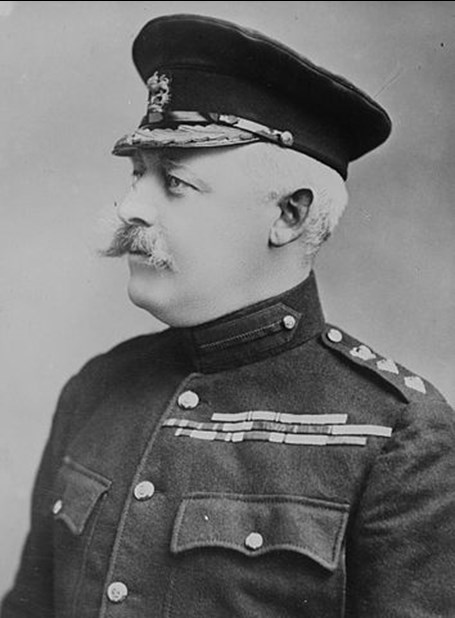
Photo: Lt-Gen Grierson
Throughout the Army there was a consistent ratio between commanders and subordinates; for instance, there were four companies to a battalion, four battalions to a brigade, and three (infantry) brigades to a division. With the BEF expected to comprise six infantry divisions plus the Cavalry Division, there was an obvious need for an intermediate layer of command between the Commander-in-Chief and the divisional commanders. This initial requirement for Corps commanders would not only persist throughout the war, but a further layer of command was created before the end of 1914, when two armies were created to administer the increasing number of Corps.[5] It is of interest that Sir John French tried to delay the creation of this extra layer of command supposedly to save the ever-reducing resource of the trained staff officer, although the real reason for Sir John's delaying tactics may have been him fearing a loss of control.[6] The creation of the two armies returned the ratio of command (from Army to Corps) to around three to one, after it had grown to seven to one before the insertion of the 'Army' level.
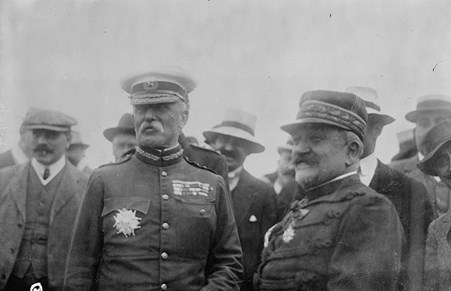
Image: Sir John French (with with the French Minister of War Jean Brun)
The creation of the 'Army' level of command immediately above Corps clearly changed the relationship between GHQ and Corps. Haig - as commander of the First Army - was determined not to be a mere postmaster; instead he saw the role of Army as that of commanding subordinate units in battle. As will be seen later, the role of Corps seemed to change in 1915; this may be due to the extra layer of command being inserted or, because after 1914 there were no more 'encounter' battles, with 1915 seeing the start of the set-piece battle.
Although Corps had been envisaged before the outbreak of war and I Corps, with a formed staff, was (in the guise of Aldershot command) ready for war, other Corps would have to be improvised. The role of these Corps was envisaged before the war as being one of 'post boxes' through which orders would pass from GHQ to divisions.[7] As Simpson points out, there is some divergence of opinion that persists to this day about the role of Corps. Simpson cites Tim Travers and suggests that Travers is wrong in his opinion that the role of Corps was limited due to its subordinate position to GHQ and Armies in the 'top down' command structure.
What is undeniable is that Corps were immobile sector-holding units, into and out of which divisions were rotated. As a result, the Corps staff needed to become knowledgeable about the geography of the sector they were holding, as divisions may not have the opportunity to familiarise themselves with the landscape over which they were to fight.[8]
The other major function of Corps related to artillery. Besides the Corps commander and his staff, at the outset of the war there were very few permanent troops attached to a Corps. The cable section of 1914 was joined in 1916 by Corps cavalry regiments, cyclist battalions, a motor machine gun battery, signal companies, ammunition parks and supply columns, workshops, and engineer and RFC units.[9] The most significant addition to the composition of a Corps was in terms of artillery. Excluding for the moment the role of Corps in planning battles, it is through the use of artillery that the role of Corps can be best explained.
Prior to the Battle of Loos, Corps commanders had on their staff a Brigadier-General Royal Artillery (BGRA) whose role was that of advisor to the Corps commander. After Loos, this officer became General Officer Commanding Royal Artillery (GOCRA). This was a move from advising the Corps commander to actually commanding any divisional artillery it was deemed necessary to coordinate at a higher level. Clearly the fact had now been realised that artillery was not just an assistance to an infantry assault, but the only method (at that stage in the war) of ensuring the infantry had a chance of achieving their objectives. The GOCRA's responsibilities were not limited to the medium sized artillery pieces; the heavy guns that were under the jurisdiction of the Commander, Corps Heavy Artillery also became his responsibility.[10]
As previously mentioned, from 1915 the main function of Corps command was the planning of battles. Simplistically, GHQ's role was the selection of the front on which the enemy was to be attacked; the Army level of command would set the objectives, whilst the Corps level would set about planning how to achieve those objectives.[11] The level of interference from above - at all levels of command - depended on the personalities involved and when in the war the attack was to be launched.
The year 1914 saw arguably the least contribution from the Corps level of command. Other than strategic decisions such as which routes to take during the retreat from Mons and the decision to turn and fight at Le Cateau (clearly a Corps decision - much against GHQ's wishes), there was little the Corps level could add to the overall instructions from GHQ. Admittedly, the use of reserves at First Ypres was critical, but it could be argued that this was a force of circumstances rather than a decision that could be made independently of the actions of the enemy. Certainly the inability to obtain information and pass instructions was a hindrance in the ability of Corps to control matters.
The advantage of sending Staff Officers from.....Corps [to] Divisions....has proved to be very great. During the fight .... despite the intention of keeping the Corps fully informed, it has been found in practice that the latter does not as a rule get as much information as desirable unless these liaison officers are provided.[12]
This problem would be wrestled with for the remainder of the war and lead to the issuing of increasingly detailed orders. (How much the fact that the communications 'system' only extended as far as Corps and so precluded Corps taking a more active role at this time, as opposed to Corps strictly adhering to Field Service Regulations and allowing Divisions to make decisions, is a matter of interest.)
The first set-piece battle of 1915 undertaken by the BEF was Neuve Chapelle. Sir Henry Rawlinson, commanding IV Corps, has not come out of this battle in a good light, despite the (at the time) perceived near breakthrough that was achieved. Prior and Wilson show that Rawlinson was over-ready to delegate the planning of this battle to his divisional commanders, asking them to come up with a scheme.[13] Had Rawlinson or other Corps commanders persisted in this approach, then there would have been little doubt that the function of Corps command was at best superfluous and at worst a hindrance to the execution of the war.
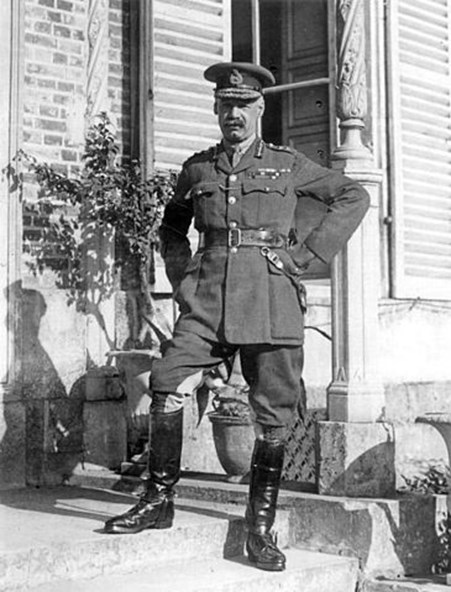
Image: General Sir Henry Rawlinson
Haig, commanding First Army, realised that Rawlinson was abrogating his responsibilities and insisted Rawlinson get a firmer grip on the situation. We do not know how much this was Rawlinson over-interpreting Field Service Regulations (which stated that decisions should be taken by 'the man on the spot'), and how much was Rawlinson either being lazy or disinclined to carry out his role. In fairness to Rawlinson, when Haig pointed out what he required Rawlinson to do, he came up with a plan which was, in its initial stages at least, reasonably successful.
In the next battle, Aubers Ridge, again fought under Rawlinson, Sir Henry took full responsibility for the planning from the start.[14] In both these battles, Rawlinson was put under pressure to attempt a breakthrough rather than simply undertake a 'bite and hold' operation. Whilst it is not appropriate here to undertake an analysis of Haig's optimism versus Rawlinson's realism, or however else this can be portrayed, this does show Haig's willingness to directly intervene in the planning of the battle.
Clearly as Army commander Haig had every right to require his subordinate to make his plan fit the objectives he had set. However, Rawlinson's unwillingness to challenge Haig can be directly linked to Rawlinson owing his career to Haig's decision to retain him as Army commander.[15] This aspect of the relationship between Haig and Rawlinson ensured, particularly early in the war, that Rawlinson was unlikely to push Haig too far if he disagreed with Haig's decisions.[16] To this extent, it could be argued that Corps Command was weak (or at least IV Corps was weak) due to Rawlinson being beholden to Haig for his position.
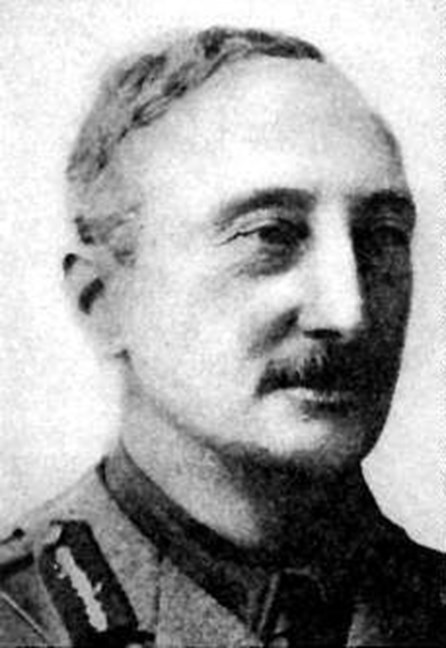
Image: Lt Gen Sir Hubert Gough
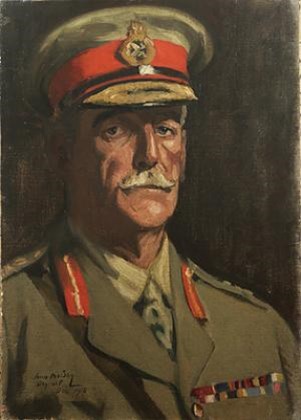
Image: Gen Sir Edward Buffin
In October 1915, there was the first instance of – as Simpson puts it – Corps command flexing its muscles.[17] Hubert Gough, commanding I Corps, issued a stinging memo to Major-General Bulfin regarding perceived shortcomings in orders he had issued to his brigades during the battle of Loos. Gough claimed that some of the orders were too detailed and some not detailed enough. This incident was an indication of Gough's style, which would be repeated later in the war. The tempo for Loos had reduced considerably, with planning for this battle commencing in early July, some 83 days before the attack. This was exacerbated by the idea that a methodical and careful bombardment was required and this led to a reduced sense of urgency amongst the planners.[18] As the planners were the Corps staff, this - if Simpson is correct - supports the idea that Corps may have been, if not weak, at least inefficient.
The aftermath of Loos led to the realisation that the new divisions (21st and 24th) comprising part of XI Corps were very inexperienced in staff work; indeed XI Corps itself was a new formation. Many of the staff officers were, to a greater or lesser degree, inexperienced and would require close supervision until they gained experience.
In conclusion, for 1915, as the artillery component of the BEF grew in line with its importance, Corps began to assume a greater importance in the conduct of operations. As the number of experienced staff officers reduced with the growth in number of divisions, more supervision was needed by Corps. Field Service Regulations ["FSR"], which was intended to give high level principles, did not give enough specific detail for inexperienced staff officers. For Corps commanders, tactics should not have been a concern, but the need for them to take responsibility in terms of gunnery meant they had to breach FSR and, rather than delegate matters, be far more prescriptive in the handling of subordinates.
The difference between the styles of command adopted by Corps can be more readily determined for the years 1916 and 1917. In this period many of the strengths and weaknesses of the different Corps can be explained by the personalities and abilities of the Corps commanders concerned, rather than the performance of their staff officers.
By June 1916, the number of Corps had risen to 18, and the number of staff officers in each Corps had also increased significantly. During the Battle of the Somme, of the fifteen British Corps, nine were engaged at one time or another on the Somme, but only four of them (II, III, XIV, and XV) took part in six or more of the twelve battles that made up the Somme fighting.[19] This implies that, once a Corps commander gained a good reputation, he was left in place. Of the commanders of these corps, Jacob (II) and Cavan (XIV) earned a good reputation, and Horne (XV) was promoted to command First Army; only Pulteney (III) earned a 'mixed' reputation. By contrast, Hunter-Weston seems to have earned a bad reputation, his Corps (VIII) being moved up to Ypres, and he did not conduct a major battle for the rest of the war.
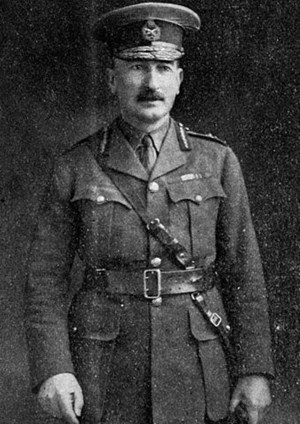
Image: Lt-Gen Claude Jacob
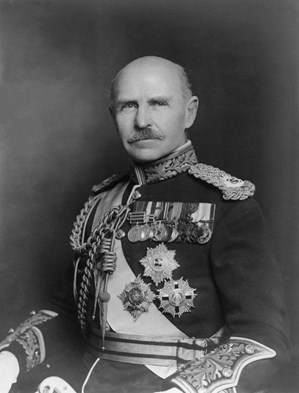
Image of Maj-Gen* Frederick Lambart, 10th Earl of Cavan
*his rank at the time of the reference
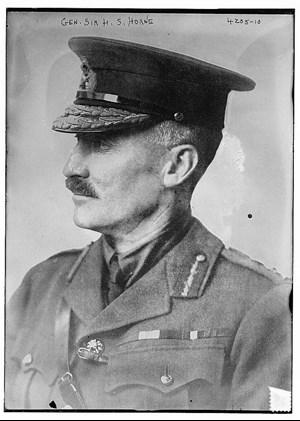
Image: Gen Sir Henry Horne
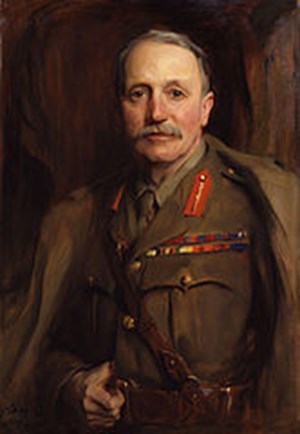
Image: Lt-Gen Sir William Pulteney
It is suggested by Simpson that there are two completely different versions of how Corps worked on the Somme. According to the Official History, plans were fully discussed between GHQ, Army, Corps and Division, but Simpson points to Travers, who suggests discussion was not encouraged and the conferences were one way - namely top down.[20]
Simpson goes on to analyse the methods of different Corps through the orders they issued. His summary of X Corps, for instance, is that it was revealing how much latitude Fourth Army gave to Corps, but how little latitude X Corps gave to the 32nd and 36th Divisions. The documents Simpson has looked at describe – without comment – how Morland (commander of X Corps) spent the entire first day of the Battle of the Somme up a tree watching the battle and how his only involvement was the piecemeal misuse of the 49th Division. At a pre-battle conference for his divisional commanders, it would seem Morland simply passed on points raised at an Army conference he attended earlier. At this earlier Corps Commanders' conference, although there may not have been much debate, at least discussion was allowed.
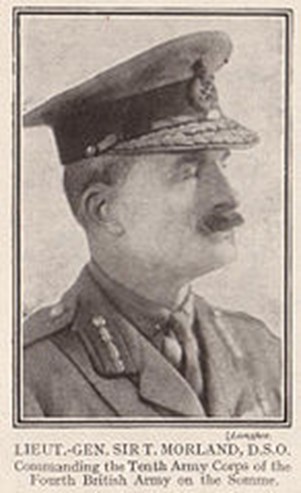
Image: Lt-Gen Sir Thomas Morland
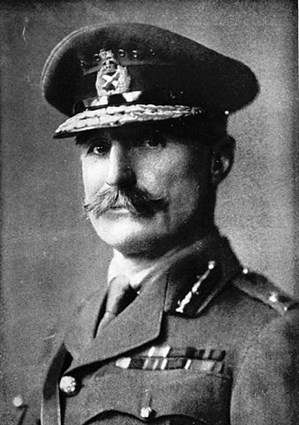
Image: Lt-Gen Sir Aylmer Hunter-Weston
In VIII Corps, Hunter-Weston seems to have given his divisions no room for manoeuvre, his orders for the battle being very detailed, down to the gap that should be given between each body in cemeteries. The orders run to over 70 pages. XIII Corps (commanded by Congreve), by contrast, whist giving similar information, went into less detail than VIII Corps.
Once the battle had commenced, there was little Corps commanders could realistically do. This did not prevent Hunter-Weston actively directing operations on 1 July, unlike Congreve who only gave minimal orders during the day, although too much cannot be read into this as the two Corps' results on 1 July were at opposite ends of the spectrum of success.
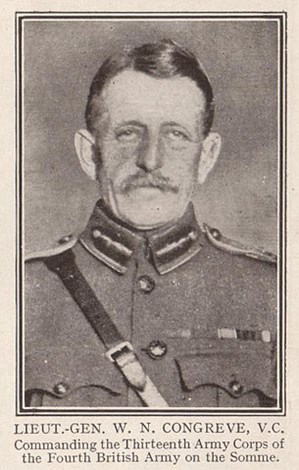
Image: Lt-Gen Walter Norris Congreve
After 1 July, there were a number of poorly co-ordinated operations by Fourth Army: not only did Fourth Army fail to co-ordinate Corps attacks but Corps failed to co-ordinate divisional attacks. Prior and Wilson suggest that Rawlinson failed to take charge of the situation and was too 'hands off' in letting these piecemeal operations take place. In one of these operations, Congreve was happy to accept a suggestion from 9th Division about the time of an attack on Trones Wood. Clearly different Corps commanders had different styles; Congreve, for instance, was content, when an attack was to be made by one division only, to allow the division to get on with it, on the basis co-ordination between divisions was not needed in the attack. Simpson goes on to show how the Army in which his Corps served could well have affected the style of a Corps Commander.
Unlike other Corps commanders who served under Gough, Lord Cavan was apparently not cowed by the "climate of fear" that allegedly permeated Fifth Army at this time.[21] Cavan had previously retired from the Army, so was less concerned about his career than other officers. Cavan from the start adopted a consultative style with his divisions. This does not mean that Cavan did not keep a close eye on his divisional commanders. Cavan's style was extended to his GOCRA who seems to have been allowed a fair amount of freedom within the Corps plan.
EA Fanshawe, who took over command of V Corps from his brother, seems to have adopted an authoritarian approach similar to Gough's. After the Battle of the Ancre Heights, a post-mortem on the attack was carried out, but Harper, GOC of the 51st Division, was not cowed by Fanshawe, even issuing a failed rebuke to Fanshawe over the way the battle was organised. Similarly, Walker of 2nd Division was firm in his defence. Simpson says that this shows some divisional commanders were more prepared to stand up to Fanshawe than Fanshawe was to Gough.
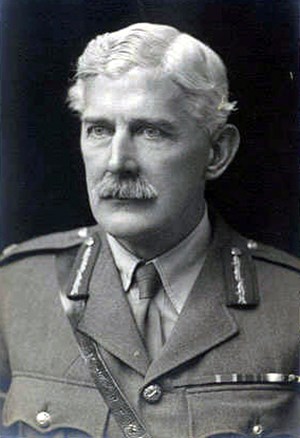
Image: Gen George M Harper
Gough's style of command was notably different from Rawlinson's and Gough's instructions to his Corps left Corps commanders in little doubt about what they should be doing. There was little scope for any common sense with Gough, for example to the extent that Corps commanders were told to closely and personally supervise the work of the GOCRA. Fifth Army's orders soon got to a stage when they hardly mentioned Corps at all; the instructions were more or less given direct to divisions, thus relegating Corps to mere post-boxes.
In 1916 the need to impose consistency led to a more prescriptive style of command. The question of how Corps commanders should exercise command was not settled but, by the end of 1916, was leaning towards an inflexible style. Corps had become important in terms of planning operations but how they went about it ranged from, for example, VIII Corps' 'hands on' style to XIV Corps' consultative style. The style of command also seems to have been affected by the Army Commander, who would also have had different ideas on how to use the Corps under him.
For the Battle of Arras, with the publication of SS135, it seems that the 'top down' ethos started to be eroded. Divisions were encouraged to nominate enemy positions that needed special treatment by the Corps' heavy guns and, if divisions needed assistance with wire cutting, they were encouraged to request it via the GOCRA.
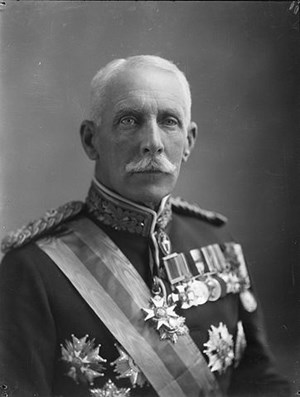
Image: Gen Sir Charles Fergusson
Simpson again analyses some individual Corps plans, starting with XVII Corps (Charles Fergusson). The orders were still very detailed at 56 pages in length, but reflected lessons learned from the Somme, such as emphasising the need for counter-battery work, the use of leapfrogging by assaulting units and the use of long pauses on objectives. It would seem that Fergusson's style was consultative, as evidenced in minutes of a XVII Corps conference.[22]
In his analysis of Corps command at Third Ypres, Simpson suggests that in this battle Corps became more of a simple conduit for information from GHQ and Army than earlier in the year. He suggests that this may be because of standardisation of attacks through the adoption of SS135; however, it may also be as a result of Gough having a fair amount of influence over matters. Surprisingly, Gough seems to have been more 'hands off' and consultative in his approach than in 1916, although this again is via a subjective interpretation of conference notes. The fact that the commander of XVIII Corps, Maxse, seems to be more influential compared to other Corps commanders may be misleading due to the amount of surviving correspondence between Maxse and Gough.
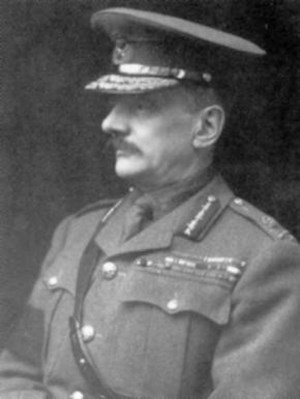
Image: Gen Sir Ivor Maxse
Going into individual Corps plans, Simpson uses XIV Corps as an example of the Corps planning for the opening of Third Ypres. Although he repeated the details of the orders that had been handed down to him, this should not necessarily be interpreted as Cavan acting as an automaton but rather a demonstration of his agreement with these orders.[23] Cavan also directed his divisions to take heed of the SS booklets. Discussion took place between Cavan and the GOCs of the Guards and 38th Divisions, and it would seem that all parties were confident in expressing their views. Cavan's instructions were 27 pages long, which compares closely with Maxse's instructions, which were 23 pages long, including appendices. We can reasonably presume that the reduction in size from the orders of Fergusson and Hunter-Weston was because divisional staff were now sufficiently experienced to know what routinely needed doing in attacks. The continuing reduction in detail was an aid to the increase in tempo of attacks that was to be made for the rest of 1917 and in 1918.
One of the problems with the attacks becoming routine was that divisional commanders may have started becoming blasé; as a result Plumer was forced to point out "The barrage plans by higher authority does not absolve divisional commanders from full responsibility to obtain a barrage meeting all their requirements".[24] This may also have been interpreted as 'don't be bullied by Corps commanders, and stand up for what you want'.
Simpson's conclusion was that Fifth Army was far less prescriptive in 1917 than in 1916 and responsibility was becoming more devolved – as prescribed by FSR – due to growing experience amongst staff officers. However, as long as many as five different barrages were needed to secure passage of troops, Corps would still dominate the planning and organisation of offensives.
The early part of 1918 showed a different role than previously for Corps. An attack by the Germans was widely expected, and GHQ passed down to the Armies the steps that had to be taken to meet the expected onslaught. There seems to be some debate about whether the principles of the defence scheme were fully understood and if the scheme was a mis-applied replica of the German system. With Corps being the formation drawing up the detailed defensive arrangements, any misunderstandings regarding the overall plan should have become apparent in Corps' plans.
Lessons from the 1918 retreat were drawn by various Corps. Both XVIII Corps and VII Corps identified the fact that the front was held too thinly, which suggests a degree of criticism of the overall defence plan. With Gough carrying the can for the 'failure' of the defence, perhaps Corps commanders were emboldened to criticise more freely, or felt the need to avoid their own possible removal by laying the blame elsewhere.
A new version of SS135 was produced in 1918, the main thrust of which was to greatly increase the idea of decentralisation with decisions made by lower formations. This is exactly what happened during the Hundred Days, with divisions being given more influence and responsibility in the planning of attacks. This resulted in much greater tempo.[25] Whether or not this would have worked quite as well had the warfare not been open is less clear.
Later during the Hundred Days, Corps were only setting rough objective points and divisions were told to advance regardless of their flanks. Artillery, including the heavy guns, were decentralised to divisions. Once resistance was met, Corps once again became more involved and centralisation of control took place again. Simpson comments on the style of Corps command in this period by citing Shute of V Corps who offered advice to his divisions but did not prescribe any approach, saying that circumstances will alter so quickly Corps would find it difficult to co-ordinate the attacks.
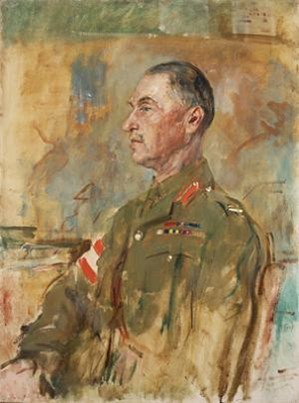
Image: Gen Sir Cameron Shute
The information drawn from Simpson's thesis demonstrates that if not the role of Corps, at least the way in which they carried out that role, changed throughout the war. A certain amount of devolution of command was achieved by 1918 which came about through a combination of experience and trust. Experience in the battles of 1916 and 1917 taught High Command that better results could be achieved if the decisions were made lower down the chain of command. Additionally, trust in the staff of the lower formations was built up, once it was found they had learned their jobs and did not need detailed orders.
An argument could be made for Haig being too loyal towards the Corps commanders, in that there seems to have been fewer sackings of under-performing Corps commanders than might have been expected. A brief analysis of Corps commanders reveals a degree of ambiguity over certain removals.
ORBAT indicates eleven Corps commanders did not survive in their posts for reasons other than promotion or injury. Some were removed ostensibly due to ill health,[26] others because they had managed to fall out with their superiors.[27] However, relatively few removals can be put down to clear-cut poor performance.[28]
Of the six longest serving Corps commanders, only one was removed,[29] so it can be concluded that either there was a great deal of tolerance, or they were generally not too bad at their jobs, or Haig missed a trick in not promoting people like Harper, Shute and Braithwaite sooner.
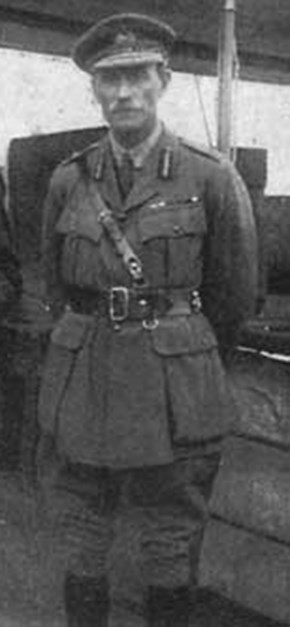
Image: Gen Walter Braithwaite
If some of these commanders were 'average', there remains the issue of those who were specifically moved into an area prior to battle, presumably to take advantage of their competence or experience. The first such example of this is Pulteney's III Corps coming down from the north prior to the Battle of the Somme in 1916 (as opposed to VII, VIII, X, XIII and XV Corps, which were also involved on the Somme). These other Corps were created and moved into line as the British-held front 'crept' southwards in 1915 and so there can be no clear show of selection for the battle as there is for Pulteney.[30] Similarly, at Arras in 1917, Congreve's XIII Corps was moved up to the line for the opening attack and at Third Ypres we see Jacob (II), Cavan (XIV) Maxse (XVIII) and Watts (XIX) all coming to the salient from elsewhere.
Conversely, Hunter-Weston was removed from the Somme soon after the first day, and was clearly 'deselected' for the opening of the Third Ypres battle, despite VIII Corps holding a relevant sector. If Haig was insufficiently confident of Hunter-Weston's abilities, so long as there was a suitable replacement, it seems strange that he would not choose to replace this Corps commander.
Some Corps commanders were certainly stronger than others in terms of their willingness to stand up to superiors,[31] and Rawlinson nearly lost his job through a junior (divisional) commander standing up to him. Some Corps commanders certainly had a great deal of difficulty in doing their jobs under Gough; they may have felt themselves to have been sidelined by Gough who, at times, seemed determined to run divisions directly from his Army headquarters.
What would now be called 'management techniques' varied between Corps commanders; these were also affected by which Army Commander the commanders were serving under. Corps commanders were no doubt affected by their relationships with each other and their superiors. All these factors would have affected Corps performance, both actual and perceived.
Whilst unfavourable comparisons can easily be drawn between British Corps and those of Australia and Canada, such a comparison is unfair as, in many respects, the comparison is of entirely different types of formation. The Australian Corps (as it was from 1918) and the Canadian Corps were national armies, through which there was no routine movement of divisions. Perhaps a limited sense of 'belonging' could have been engineered by making British Corps similarly permanent organisations; certainly Corps commanders would, by this method, have had a better chance of getting to know their subordinate formations.[32]
Of course, there may have been some advantages in keeping divisions together under one Corps but the difficulty of moving an entire Corps of two or three (or more) divisions, plus heavy artillery, would far outweigh whatever advantages could be gained. Therefore from the simple logistical point of view, Corps were never likely to change to the dominion model and consequently remained 'sector holding' formations. This role certainly is less appealing to write or read about than a division's war record and this may have led to the dearth of material on the subject of Corps.
Corps command is therefore not at all a weak link but a very necessary link in the chain of command. Some Corps commanders had mixed fortunes and this may be attributable to the Army commanders they served under. Some Corps commanders may have been kept on longer than others, at the expense of some of the better divisional commanders but, overall, it would seem that there was always the chance of being sent home if a commander's health or abilities broke down.
It is the lack of information that has possibly led to the perception of Corps being a weak link. Although the role of Corps remained relatively unchanged during the war, there was a shift downwards in responsibilities, which became more obvious in 1918. This lowering in the 'centre of gravity' of responsibilities came about with the increased experience of staff officers, thus in 1918 only the lightest of touches was needed by Corps during open warfare.
Article by David Tattersfield
Further information
The WFA's YouTube channel has an excellent presentation entitled Achieving the Impossible?: Aylmer Hunter-Weston at Gallipoli
Also on the YouTube channel is WFA Vice President John Bourne talking about Hiring and Firing on the Western Front
References:
[1] Andrew Simpson, 'The Operational Role of British Corps Command on the Western Front, 1914-1918' (unpublished PhD thesis, 2001), page 2.
[2] Simpson, Thesis, page 21.
[3] Unless otherwise stated "Corps" will mean British as opposed to the Australian or Canadian Corps.
[4] Simpson, Thesis, page 22 quotes correspondence between Haig and Robertson in 1908. It was intended that the BEF would contain six infantry divisions, although only four were immediately despatched on the outbreak of war.
[5] On 26 December 1914, when First and Second Armies were formed, there was, in France and Belgium, four Corps (V Corps was in the process of forming in the UK) plus the Cavalry Corps, and the Indian Corps.
[6] Niall Barr 'Command in the Transition from Mobile to Static Warfare, August 1914 to March 1915', in Gary Sheffield and Dan Todman, eds., Command and Control on the Western Front. The British Army’s Experience 1914-1918 (Staplehurst: Spellmount, 2004), page 30.
[7] Simpson, Thesis, pages 22 - 23.
[8] Sanders Marble, 'Command of Artillery: the case of Herbert Uniacke', in Gary Sheffield and Dan Todman, eds., Command and Control on the Western Front. The British Army’s Experience 1914-1918(Staplehurst: Spellmount, 2004), page 202.
[9] Andrew Simpson, 'British Corps Command on the Western Front 1914-1918 in Gary Sheffield and Dan Todman, eds., Command and Control on the Western Front. The British Army’s Experience 1914-1918 (Staplehurst: Spellmount 2004), page 102.
[10] Simpson, 'British Corps', page 103 and Marble, 'Herbert Uniacke', page 200.
[11] Marble, 'Herbert Uniacke', page 203.
[12] Barr, 'Command in Transition', page 19.
[13] Robin Prior and Trevor Wilson. Command on the Western Front (Revised paperback edition, Barnsley: Pen and Sword, 2004), pages 25-29.
[14] Prior & Wilson, Command, page 82.
[15] After the disagreement over the blame for Maj.-Gen. F.J. Davies's 8th Division's failure. See Prior & Wilson, Command, pages 70-73.
[16] See Prior & Wilson Command, page 97 for Rawlinson paying lip service to Haig's requirements, such as the 'pious aspiration' of the plans for Givenchy. See also page 107 for Rawlinson's private thoughts on the likelihood of gaining the second line at Loos.
[17] Simspon, Thesis, page 38.
[18] Simspon, Thesis, page 40.
[19] Major A F Becke, Order of Battle of Divisions (Reprinted, Newport: Ray Westlake 1989).
[20] Simpson, Thesis, page 52.
[21] Ian Beckett, 'Hubert Gough, Neill Malcolm and Command on the Western Front' in Brian Bond, et al., Look to Your Front: Studies in the First World War by The Commission for British Military History(Staplehurst: Spellmount 1999), page 2.
[22] Simpson, Thesis, page 90 and page 95.
[23] Simpson, Thesis, page 121.
[24] Simpson, Thesis, page 136.
[25] An example of the increase in tempo is that of the attack by IV Corps (Harper). A Corps conference was held at 4pm on 22 August, the artillery maps printed by 2am, and the attack went in at 11am on 23 August. The time from conference to zero hour was 19 hours. Simpson, Thesis, page 193
[26] Snow, Congreve, Hamilton Gordon (at Rawlinson's behest), McCracken (possibly due to age).
[27] Anderson, Keir, DuCane.
[28] Pulteney, Woollcombe, Edward Fanshawe, Hew Fanshawe. I owe information in this passage to Dr John Bourne
[29] Pulteney after 1300 days. The others were Fergusson (1412 days), Morland (1214 days), Haking (1164 days), Hunter Weston (968 days) and Kavanagh (953 days). Simpson, Thesis, page 225.
[30] In April 1916 Pulteney was allocated a new BGRA, Herbert Uniacke "this was a deliberate step" according to Marble. This is possibly an example of Pulteney being given gifted subordinates to compensate for his perceived shortcomings. Marble, 'Herbert Uniacke', page 203.
[31] Cavan is a case in point here; having retired from the Army before the war, he probably felt he had nothing to lose in standing up to the likes of Gough.
[32] Jacob, referring to the 56th Division is reported as saying he "knew very little about this Division" whilst under his command at Polygon Wood in 1917. Simpson, Thesis, page 142.





